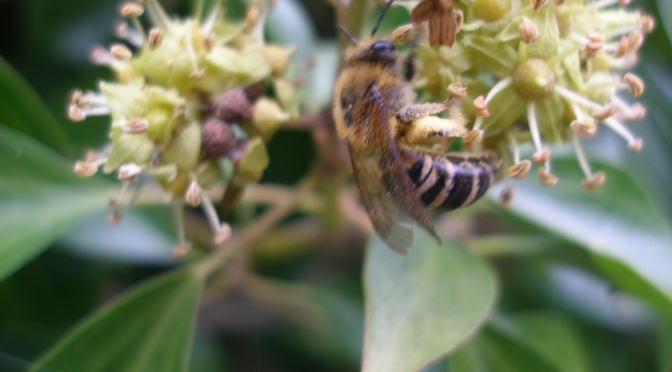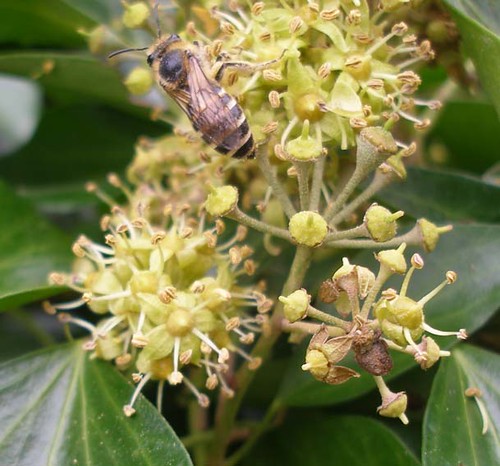Last Sunday, we enjoyed a walk around the small Devon seaside town of Salcombe. It’s a pleasant place now that the season is over and we relished the views over the estuary on this cooler but dry day. I don’t know whether I am looking more carefully or perhaps I haven’t previously visited Salcombe at this time of year? I didn’t remember the profusion of flowering ivy.

A narrow coast road links the town to its two beaches, North Sands and South Sands. On one side of this road there are low cliffs dropping to the sea and all along the cliff tops were huge banks of ivy. Given my recent experience, I now search any stand of flowering ivy for Ivy Bees and the Salcombe cliffs did not disappoint.
Wasps were the predominant insect on the ivy flowers but there were also quite a few of the sleek, slender, yellow and black-banded Ivy Bees (Colletes hederae) with their characteristic russet hairs. The wasps mostly tolerated their company although I did see one attack an Ivy Bee. The bee fell away but I could not be sure if it died or just sloped off.
The Ivy Bees at this site seemed to be moving about less than when I had seen them before. Once they had found a suitable flower head they spent some time exhaustively probing its flowers. Perhaps there was more pollen and nectar available? Perhaps it was cooler? I looked for colonies but did not locate any; I presume the nests are in nearby cliffs but as these are mostly private land they are out of bounds to Ivy Bee-nerds like me.
What I am beginning to realise is that, in this part of Devon, Colletes hederae is doing rather well with large colonies and large numbers. They also don’t seem to mind the cooler damper weather we have been experiencing.
It’s good to have a positive bee story to tell.
We visited Salcombe on October 12th 2014.
For those interested in Ivy Bees, they featured in the Guardian Country Diary this week




Yes, good news indeed!
LikeLike
Thanks Cathy.
LikeLike
It is a very positive bee story. I have never seen any aggression amongst other pollinators on the ivy but perhaps later on in the season the wasps have shorter tempers. I think we do become more aware of what is around us when it interests us. I’m sure on future walks you will find more nests. I always keep a look out on sunny slopes all year round for other nesting bees but so far I have only found bees that nest on the flat. I will have to extend my search next year. Amelia
LikeLike
Thanks, Amelia. The solitary bees I have seen this year have inspired me to look more closely next year.
LikeLike
I’d like to see an ivy bee, she looks so pretty. I think there have been less wasps about in recent years, though this year they seem to have made a comeback. I hope they don’t mind sharing the ivy 😉
LikeLiked by 1 person
Thanks, Emma, they are very pretty and it has been quite a surprise to see so many so late in the year. Mostly the wasps and bees seem to get along OK.
LikeLiked by 1 person
Apparently sometimes ivy nectar crystallises on the flowers because it is such a high sugar nectar. I found what I think is some ivy nectar in one of my hives this week, it was white and quite crunchy with little moisture.
LikeLike
Thanks, Emily, that’s very interesting. Does the high sugar content cause any problems for the bees?
LikeLike
The high sugar content makes the nectar very attractive to the bees. Some beekeepers say that ivy honey makes bad winter food for the bees, as it is high in glucose so crystallises hard. Other beekeepers disagree. If only the bees would let us know their opinion!
LikeLike
Perhaps the bees are telling us their opinion by consuming the ivy nectar?
LikeLike
Ivy bees, and not just bees loving ivy! Who’d a thunk it?
LikeLike
Who’d a thunk it indeed! It’s worthwhile reflecting that, for the honeybees ivy is their “last chance saloon” and, for the ivy bees it is almost their only saloon.
LikeLiked by 1 person
A very interesting post Phillip and comments.I saw my first Ivy Bees last month,and a few hundred too on cliffs in the south of the Isle of Wight.
All were still very busy coming and going from their burrows.
http://www.wightbumblebees.blogspot.co.uk
LikeLike
Thanks, Peter. I had a look at your website and there are some beautiful pictures of Ivy Bees!
LikeLike
Thank you Phillip for taking the time to visit my blog.I am very new to bees and have discovered a lot about them during this year.
LikeLike
Have you reported your obsevations to the BWARS? They would be very keen to hear.
LikeLike
I never knew there were ivy bees! All we have here in southern California are the European honey bees on the ivy. It just hums in the winter. Can’t get near it. You have opened my eyes. I will be looking for other species of bees soon. So much to learn! So much fun!
LikeLike
Thanks, Jane. I don’t think the Ivy Bee (Colletes hederae) is found in southern California but I am sure there are plenty of other interesting insects to be spotted when the ivy is in flower.
LikeLike
Hello Philip. Thanks for leaving the link to this post on my blog. I’m wondering if you would look at the entry I made on iSpot hoping I’d seen an ivy bee. It was identified as a hoverfly but I’m still hoping . . . http://www.ispotnature.org/node/451891 . It was in an awkward place to photograph. I had to poke my camera round a corner to get it so maybe not enough of it is view to tell properly but I’d be interested to know what you think.
LikeLike
P.S. Maybe the hairs on the one I saw weren’t russet enough?
LikeLike
Sorry to disappoint you, Lucy, but it’s not an Ivy Bee (the stripes aren’t right), more likely a hoverfly which are also very keen on flowering ivy. But Dorset is a good place to see Ivy Bees so perhaps we should organise an Ivy Bee safari next year.
LikeLike
Thanks for your suggestion re BWARS Phillip.
I submitted my Ivy Bee location and received an email from Stuart Roberts.
LikeLiked by 1 person